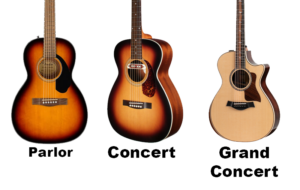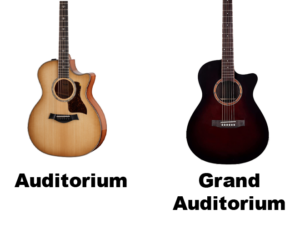Uncategorized
Guitar vs. Bass: Unveiling the Melodic Battle
In the grand orchestra of musical instruments, few instruments stand as iconic representatives of rhythm and melody like the guitar and bass. These two siblings of strings, each with its distinct voice and role, have woven their way into the fabric of countless compositions, lending depth and character to the world of music. But how do these instruments differ, and what unique contributions do they make to the musical tapestry? Join us as we delve into the harmonious rivalry of guitar vs. bass, exploring their individual characteristics, roles, and the fascinating interplay between them.
The Melodic Duel: Guitar
Versatility and Melodic Mastery: The guitar, with its six strings and fretted fingerboard, emerges as a versatile virtuoso capable of producing a vast array of melodies, harmonies, and rhythms. From the gentle strumming of folk ballads to the blazing solos of rock and metal, the guitar’s melodic potential knows no bounds.
Chords and Harmony: One of the guitar’s defining features is its ability to play chords. Strumming a chord progression can create lush harmonies that underpin the melody, giving songs their distinctive character. The guitar’s wide tonal range allows players to explore various genres, from the twangy notes of country to the complex harmonies of jazz.
Lead and Rhythm: Guitarists often divide their roles between lead and rhythm playing. Lead guitarists captivate audiences with searing solos and intricate melodies that soar above the music. Rhythm guitarists provide the foundation with powerful chord progressions and rhythmic patterns, anchoring the song’s structure.
The Rhythmic Beat: Bass
Groove and Foundation: Enter the bass guitar, the heartbeat of the ensemble. With its deep tones and four strings, the bass guitar occupies a unique rhythmic and harmonic role. While its melodic range may be more limited than the guitar, its impact on the overall sound is profound.
Rhythmic Drive: The bass guitar drives the rhythm and groove of a song, serving as the glue that holds the musical elements together. Its steady pulse and syncopated rhythms lay the foundation upon which other instruments can build.
Harmonic Anchoring: While the bass may not play intricate melodies like the guitar, it provides essential harmonic support. Basslines outline the chord progressions and contribute to the song’s tonal structure, ensuring that the melody and harmony are tightly interwoven.
The Harmonious Interplay
Synergy and Symbiosis: Guitar and bass share a symbiotic relationship, each enhancing the other’s impact. Together, they form a dynamic duo that enriches the musical experience.
Counterpoint and Complement: The interplay between guitar and bass allows for intriguing musical conversations. The bassline’s movement can complement the guitar’s chords, creating an engaging harmonic dialogue that elevates the song’s complexity.
Groove and Texture: The rhythmic groove of the bass provides the backdrop against which the guitar can shine. The guitar’s melodic flourishes enhance the texture of the music, weaving a sonic tapestry that captivates the listener.
Collaboration and Creativity: Whether in a rock band, jazz ensemble, or acoustic duo, guitar and bass players collaborate to shape the sonic landscape. Their ability to work in harmony while showcasing their individual strengths adds depth and dimension to the music.
The Final Chord
In the spirited duel of guitar vs. bass, there is no clear winner, as both instruments contribute their unique voices to the musical chorus. The guitar dazzles with its melodic prowess and harmonic richness, while the bass lays down the rhythmic foundation and harmonic bedrock. Individually, they shine; together, they create a symphonic unity that resonates with depth, emotion, and creativity. Whether you’re strumming a guitar’s delicate melodies or feeling the bass’s pulsating rhythms, the interplay of guitar and bass is a testament to the power of collaboration in the realm of music.
Uncategorized
Acoustic Guitar Sizes: Finding Your Perfect Fit
Have you ever wondered how the size of an acoustic guitar affects its sound? From the intimate, focused tones of a parlor guitar to the deep, resonant sound of a jumbo, the size and shape of an acoustic guitar can have a profound impact on its sonic characteristics.”
In this article, we’ll explore acoustic guitar sizes, their variations, and how to choose the perfect size that suits your needs.
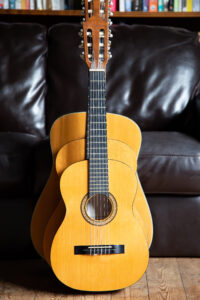 Understanding Acoustic Guitar Sizes: A Musical Puzzle
Understanding Acoustic Guitar Sizes: A Musical Puzzle
Acoustic guitar sizes refer to the dimensions and proportions of the guitar body, which significantly influence the instrument’s tonal characteristics, projection, and playability.
Just like pieces of a musical puzzle, different sizes create distinct voices that cater to various playing styles and preferences.
The Spectrum of Acoustic Guitar Sizes
Acoustic guitars come in several sizes, each with its unique qualities and attributes. Let’s explore some common acoustic guitar sizes and their defining features:
-
-
Parlor Guitar: The parlor guitar is petite and charming, making it an ideal companion for intimate settings.
The name comes from the rooms in which the guitar was typically played in the late 19th century.
Some famous musicians who have been known to use the parlor guitar are, Eric Clapton, Mark Orton, Ed Sheehan, and John Mayer
Its smaller size results in a focused and balanced sound, perfect for fingerpicking and folk music.
-
Concert Guitar: Slightly larger than the parlor guitar, the concert guitar offers enhanced projection and volume. It strikes a balance between portability and sound, making it versatile for various genres.
It is often used in classical music and flamenco music with its full sound.
-
Grand Concert Guitar: With a larger body than the concert guitar, the grand concert guitar boasts a fuller sound and improved tonal complexity.
A popular choice for those who have a smaller stature and require an instrument that’s built to a shorter scale. Great choice for traveling musicians who often play live performances.
It’s suitable for fingerstyle playing and intricate arrangements.
-
Auditorium Guitar: The auditorium guitar, also known as the orchestra model (OM), features a well-rounded sound with a pronounced midrange.
More shallower than the dreadnought and narrower in width than a concert guitar. An Auditorium guitar brings the body closer to the player, making it feel more intimate and comfortable for stage use.
Some famous musicians who play it include Ed Sheeran, John Mayer, and Eric Clapton.
-
Grand Auditorium Guitar: Expanding on the auditorium guitar’s design, the grand auditorium guitar offers a versatile sound profile with enhanced bass response and overall volume.
It is a versatile mid-sized guitar that is a good choice for those who want a single guitar to travel with. The tone is great for strumming and picking. It performs well on stage and in the studio.
It suits a wide range of musical genres.
-
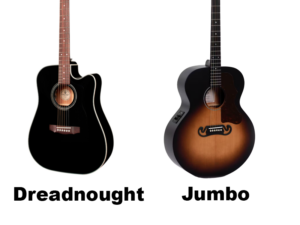 Dreadnought Guitar: The Dreadnought is a true icon, known for its bold and powerful sound. Its large body produces a strong bass response, making it ideal for strumming and vocal accompaniment.
Dreadnought Guitar: The Dreadnought is a true icon, known for its bold and powerful sound. Its large body produces a strong bass response, making it ideal for strumming and vocal accompaniment.This guitar is known for its powerful voice and lower-mid-rich tones that make it a favored choice for country artists. Although it is a popular choice for musicians of all genres.
Some famous musicians who play the dreadnought guitar include Hank Williams Jr, Elvis Presley, Keith Richards, Thom Yorke, and Kurt Cobain.
The original dreadnought guitars were made for the Oliver Ditson Company and featured mahogany backs and sides and spruce tops.
-
Jumbo Guitar: The jumbo guitar lives up to its name with a massive body that delivers robust volume and a deep bass presence.
This is the largest of the guitar family with a deeper body than the popular dreadnought. The body is wider and deeper than traditional acoustic guitars, which gives them a unique appearance.
Jumbo’s are well suited to rhythm guitarists in country and folk rock, and produce a deep rich sound favored by heavy strummers. Some famous musicians who play this guitar are Elvis Presley, George Harrison of the Beatles, Neil Young, Sheryl Crow, and Pete Townshend of The Who.
Choosing the Right Acoustic Guitar Size for You
Selecting the right acoustic guitar size involves considering factors such as playing style, comfort, and tonal preferences. Here are some steps to guide you on your quest:
-
Identify Your Playing Style: Determine whether you lean towards fingerpicking, strumming, or a mix of both. Different sizes excel in different playing styles, so choose one that complements your technique.
-
Consider Body Comfort: Hold and play guitars of various sizes to assess comfort. A guitar that fits well against your body ensures a pleasant playing experience, especially during extended sessions.
-
Evaluate Sound Preferences: Listen to the sound produced by different acoustic guitar sizes. Pay attention to tonal qualities, such as warmth, brightness, and projection, to find the one that resonates with your musical taste.
The Influence of Acoustic Guitar Sizes on Music
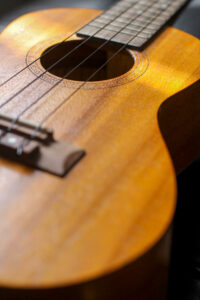 Acoustic guitar sizes and shapes can have a significant impact on the sound of the instrument.
Acoustic guitar sizes and shapes can have a significant impact on the sound of the instrument.The size of the guitar body type also relates to the volume of air within the instrument. Changes to the air capacity of the body will emphasize specific frequencies. A smaller body will have a more focused sound centered on higher frequencies, while a larger body will produce deeper low-end frequencies.
Body dimensions can provide some indication of the tone you might expect, but other factors exert a profound influence, too. Much depends on the tonewoods used to construct the body and the shape, size, and layout of the braces.
Finding Harmony in Acoustic Guitar Sizes
By delving into the nuances of size, sound, and playability, you’ve gained insights that will guide you toward the perfect fit for your musical aspirations.
As you continue your exploration, remember that each acoustic guitar size has its own unique voice and character. Embrace the joy of trying different sizes, celebrate the nuances of their sounds, and let your heart lead you to the one that resonates with your musical soul.
-
Uncategorized
Exploring the Mysteries of the Eb Chord: Unveiling Harmonious Delights
Hello, fellow music enthusiasts and budding guitarists! Are you ready to embark on a delightful journey into the world of the Eb chord? Today, we’ll unravel the enchanting allure of this chord, delving into its harmonious wonders and understanding how to play it on your guitar. Whether you’re a beginner eager to expand your chord repertoire or a curious soul seeking to enhance your musical knowledge, this guide is your gateway to mastering the mesmerizing “Eb chord.” So, grab your guitar, find a cozy spot, and let’s dive into the melodious realm of musical expression and creativity!
Decoding the Eb Chord: A Harmonious Adventure
Picture the Eb chord as a key that unlocks a magical door to a world of musical possibilities. This chord, also known as E-flat chord, carries a unique tonal quality that adds depth and intrigue to your playing. Let’s embark on a journey to discover the mechanics of forming and playing the Eb chord on your guitar.
Mastering the Eb Chord: Crafting Musical Brilliance
To play the Eb chord, follow these steps:
1. Finger Placement: Begin by placing your index finger on the 1st fret of the A string (the fifth thickest string), marking the root note (Eb).
2. Middle Finger: Position your middle finger on the 3rd fret of the D string (the fourth thickest string), forming the major third (G).
3. Ring Finger: Place your ring finger on the 3rd fret of the G string (the third thinnest string), creating the perfect fifth (Bb).
4. Pinky Finger: Finally, use your pinky finger to press down on the 3rd fret of the B string (the second thinnest string), adding the major seventh (D).
5. Strumming: Focus on strumming the low E, A, D, G, and B strings (the thickest through second thinnest strings) while avoiding the high E string (the first string).
6. Sound Check: Strum the strings individually to ensure each note rings out clearly. Adjust finger placement if needed for a resonant sound.
Exploring Eb Chord Variations: Adding Flair to Your Playing
While the Eb chord is inherently captivating, you can add variations to enhance its sonic potential. Here are a couple of ways to experiment:
1. Fingerpicking Patterns: Dive into fingerpicking techniques to create intricate patterns that highlight the individual notes of the Eb chord.
2. Arpeggios: Practice playing the notes of the Eb chord individually in a sequence, crafting arpeggios that flow like a gentle stream.
The Eb Chord in Action: Musical Styles
The Eb chord’s rich and versatile sound makes it a favorite choice across various musical genres. Here are a few popular songs that feature the Eb chord:
1. “Someone Like You” by Adele: The Eb chord adds emotional depth to this heartfelt ballad, contributing to its soul-stirring melody.
2. “Hallelujah” by Leonard Cohen: This iconic song showcases the Eb chord’s evocative resonance, creating an atmosphere of introspection.
Tips for Mastering the Eb Chord
As you embark on your journey to master the Eb chord, consider these tips to enhance your playing:
1. Practice Regularly: Dedicate focused practice time to build muscle memory and finger strength for the Eb chord.
2. Smooth Chord Transitions: Work on transitioning smoothly between the Eb chord and other chords to improve your overall playing fluency.
3. Experiment with Dynamics: Play the Eb chord with varying degrees of intensity to explore its full range of tonal expression.
Conclusion: Embrace the Magic of the Eb Chord
Congratulations, you’ve delved into the harmonious world of the Eb chord! As you strum, experiment with variations, and play songs, you’ll discover the power of this chord to infuse your music with elegance, depth, and resonance. Keep practicing, keep exploring, and keep embracing the enchanting allure of the Eb chord. It’s your key to a world of musical expression, where each note resonates with sophistication and allure. So, pick up your guitar, let your fingers dance across the strings, and let the captivating Eb chord lead you toward a realm of melodies that captivate the senses and stir the soul, one harmonious note at a time!
Uncategorized
Striking the Right Chord: Unveiling the Art of Guitar Pick Thickness
In the enchanting realm of music, every choice a musician makes contributes to the symphony of sound they create. When it comes to playing the guitar, one seemingly small decision—the thickness of the guitar pick—can have a significant impact on the tone, technique, and overall experience. Whether you’re a seasoned strummer or a budding guitarist, understanding the nuances of guitar pick thickness is a key step in shaping your sonic journey. This article will take you on a harmonious exploration of the world of guitar pick thickness, revealing how this seemingly modest piece of plastic can wield a profound influence on your musical expression.
The Spectrum of Thickness
Guitar picks come in a variety of thicknesses, ranging from paper-thin to heavy-duty. The measurement of pick thickness is often denoted in millimeters, with thinner picks having lower measurements and thicker ones having higher measurements. As a guitarist, your choice of pick thickness can influence several aspects of your playing:
1. Tone and Texture: The thickness of your guitar pick can significantly alter the tone produced by your instrument. Thinner picks tend to produce a brighter, crisper sound with more high frequencies, while thicker picks can result in a warmer, mellower tone with enhanced low frequencies. The texture of the pick, whether smooth or textured, can further affect the attack and resonance of each note.
2. Strumming and Picking Technique: The thickness of the pick can influence your strumming and picking technique. Thinner picks are well-suited for strumming and creating a fluid motion across the strings. On the other hand, thicker picks provide more resistance, making them ideal for precision picking and intricate patterns.
3. Articulation and Control: Thinner picks offer greater flexibility, allowing for easier bending and vibrato techniques. Thicker picks provide enhanced control and articulation, making it easier to execute precise and accurate note changes.
4. Speed and Shredding: For guitarists who indulge in speedy solos and shredding, the thickness of the pick can impact your ability to glide across the strings effortlessly. Thinner picks may be favored by those seeking rapid picking, while thicker picks can offer stability and control at high speeds.
Finding Your Perfect Match
Choosing the right pick thickness is a personal journey that depends on your playing style, musical preferences, and the sound you wish to achieve. Here are some tips to help you find your perfect match:
1. Experimentation: Begin by experimenting with picks of different thicknesses. Play the same passage using picks of varying thicknesses to compare the tonal differences and how each pick feels in your hand.
2. Genre and Style: Consider the genre of music you enjoy playing. Thicker picks may be preferred for genres like rock, metal, and jazz, while thinner picks could be suitable for folk, pop, or acoustic styles.
3. Comfort and Feel: Pay attention to how comfortable each pick feels in your hand. Some guitarists prefer the flexibility of thinner picks, while others find the stability of thicker picks more suitable.
4. Adaptation: Keep in mind that your preference for pick thickness may evolve over time. As your playing style and technique develop, you might find that your ideal pick thickness changes as well.
Conclusion
The world of guitar pick thickness is a captivating journey that invites you to explore the realms of tone, technique, and personal expression. As you strum, pluck, and unleash melodies upon the strings of your guitar, remember that the thickness of your pick is a silent collaborator in the creation of your musical masterpiece. Whether you’re unleashing powerful riffs, crafting delicate melodies, or embarking on an electrifying solo, the pick you choose holds the power to shape the very essence of your sound. So, venture forth with curiosity and an open ear, and let the quest for the perfect guitar pick thickness be a delightful symphony of discovery in your musical odyssey.
-
advanced9 years ago
How to Play “Sleepwalk” on the 3-String Guitar! Guitar TABs Included!
-
beginner8 years ago
3-String or 4-String? How to Decide Which is Right for You!
-
beginner9 months ago
Exploring Different Guitar Types: A Beginner’s Guide
-
Blues Guitar8 years ago
Go-To Tunings for Blues Slide Guitar
-
advanced9 months ago
Fun and Effective Guitar Exercises: Elevate Your Playing with These 5 Simple Techniques
-
Uncategorized9 months ago
Acoustic Guitar Sizes: Finding Your Perfect Fit
-
Blues Guitar7 years ago
Jack Daniel’s Whiskey Barrel Guitar: How It’s Made and What it Sounds Like
-
Guitars9 months ago
Bass vs Guitar: Exploring the Musical Journey

